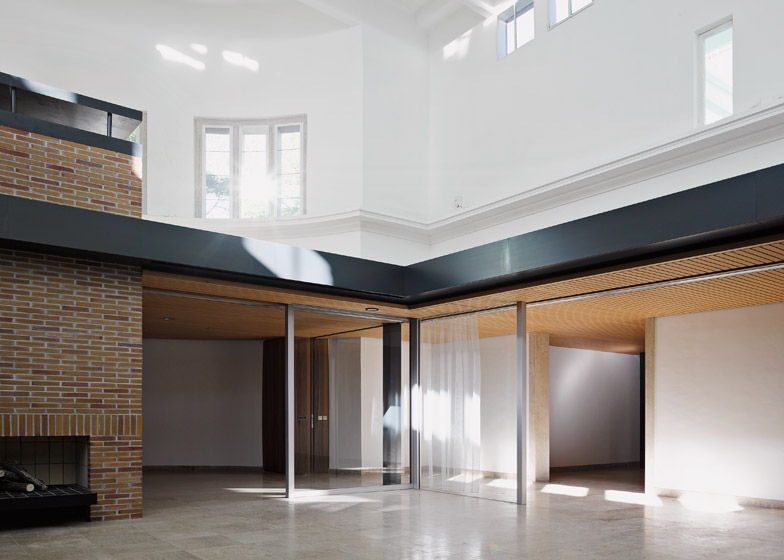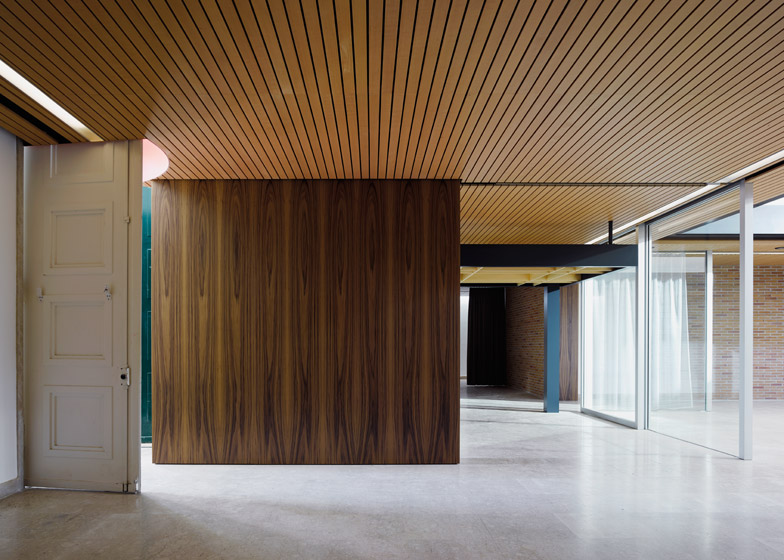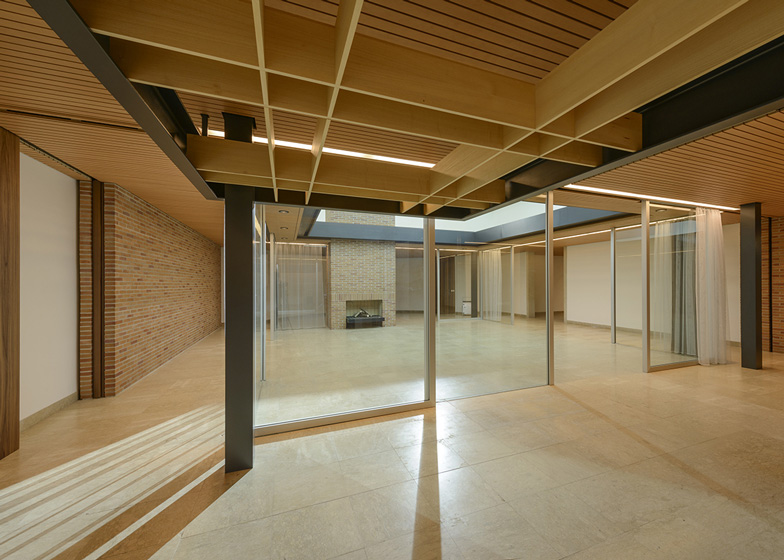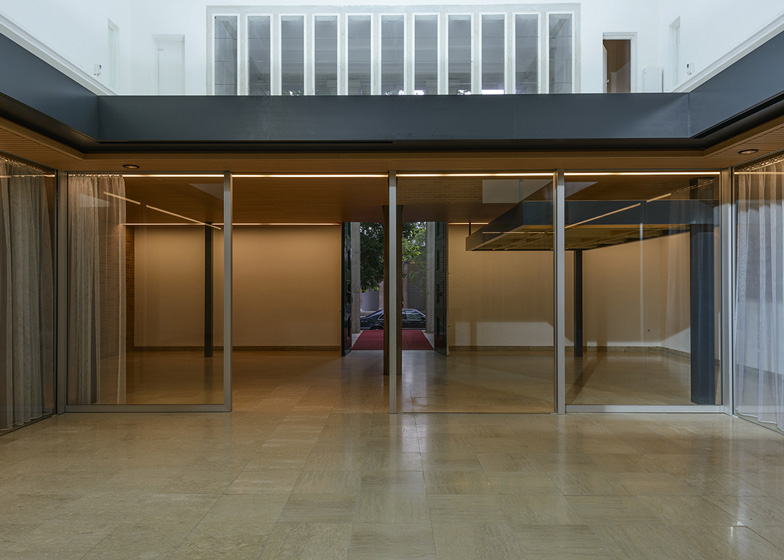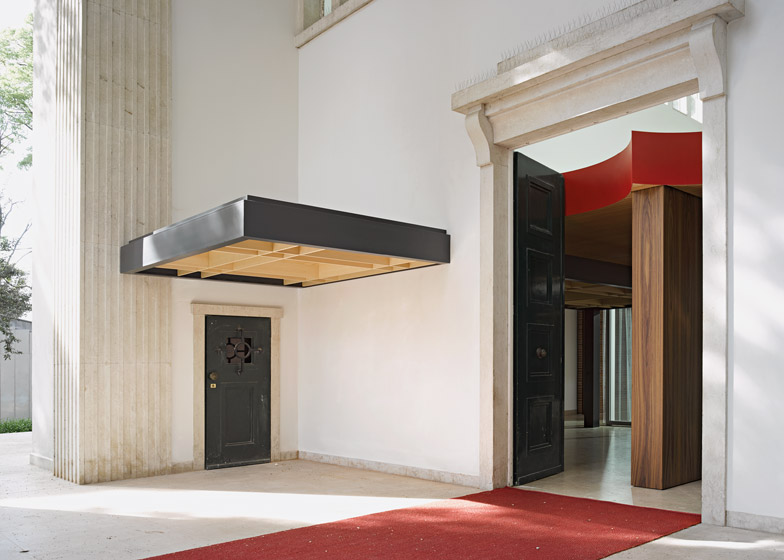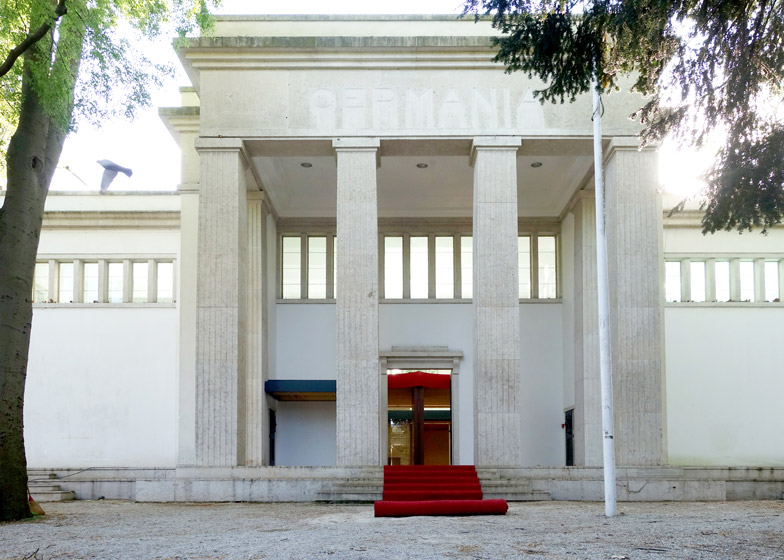Venice Architecture Biennale 2014: the German pavilion at this year's Venice Biennale features a full-size partial replica of a building made famous through 30 years of political news broadcasts (+ slideshow).
German architects and curators Alex Lehnerer and Savva Ciriacidis have reconstructed parts of the Kanzlerbungalow (Chancellor's Bungalow) in Bonn – a building completed in 1964 by architect Sep Ruf that was home to the German chancellor up until 1999.
Named Bungalow Germania, the project seeks to capture the spirit of a building that became ubiquitous in the West German media across the tenure of the Bonn Republic. This is juxtaposed against the architecture of the German pavilion, which was extensively remodelled in 1938 in the spirit of the German Reich.
"In Venice, we want to bring together the overlapping narrative strands of the nation and the architecture it has produced over the past century," said Lehnerer and Ciriacidis.
"We want to make these two opposing political buildings speak in Venice, and instigate a conversation where they are on an equal footing," they said. "As architects, we want to use architectural means to grapple with history, through an architectural montage of these two buildings that connects ideas, moments in time, actual places, and spaces to each other."
The installation features many elements taken from the original building. A brick fireplace forms the heart of a living room in the centre of the space, while other rooms include a kitchen and a study.
Outside the pavilion, the curators have parked the official car used by Helmut Kohl, who served as chancellor between 1982 and 1990, and was the last resident of the bungalow.
Previews of the Venice Architecture Biennale open today. The festival also includes an exhibition of images of Nordic-influenced architecture built in East Africa and the presentation of a masterplan for the relocation of an entire Swedish city. See all of our Venice Architecture Biennale 2014 coverage »
Here's a full statement from Lehnerer and Ciriacidis:
Bungalow Germania
This year, for the first time, countries participating in the 14th International Architecture Exhibition – la Biennale di Venezia were asked to engage with a shared theme. Artistic Director Rem Koolhaas asked each country to consider the development of their respective national architecture in response to the motto Absorbing Modernity: 1914–2014. His hypothesis is that within the field of architecture, characteristics of national diversity have receded over the past century in favor of a global, modern architectural language. This perspective on architecture and its history is intrinsically connected to national history. In Venice, we want to bring together the overlapping narrative strands of the nation and the architecture it has produced over the past century. Rather than presenting a chronological exhibit with an explicit beginning and end, however, we have chosen to do so by constructing and staging a particular architectural moment.
But how could we transport both narratives to one actual location, such as the German Pavilion in Venice, and condense them into a single point in time allowing visitors to read and experience one hundred years of German history at once? And which story should we tell about Germany’s modernisation between 1914 and 2014? Is it even possible to access Germany’s history through architectural means? How has Germany represented itself through its architecture in this century of cultural, political, and social fractures?
We accepted Koolhaas' suggestion for an architectural and historical research approach, and scoured the country for a building that was no older than one hundred years and that was instrumentalised by its owners as a statement on nationhood or as a promise to the nation. We were hunting for a "political building" that, aside from its physical reality, could be seen as a communicative medium charged with meaning.
The image of the "Kanzlerbungalow" [Chancellor’s Bungalow] in Bonn as portrayed in the German media came into our minds. The German Chancellor's former official residence was not only an important political building, but also pointed toward yet another great twentieth-century invention: the life of architecture in pictures, permitting the conscious staging of both.
Hidden away in a park by the Rhine River, the Kanzlerbungalow in Bonn never had a public facade, yet was ubiquitous in the media for many years as the backdrop for all kinds of political gestures and activities. In 1964, Ludwig Erhard had asked his friend, the architect Sep Ruf, to build him an architectural prototype of privacy along American lines. The building was to function more as a residence and an intimate gathering spot than as a governmental building. The domestication and the private, familiar aura of politics that the Kanzlerbungalow embodied as the "living room of the nation" was part of the Federal Republic’s "brand", given that at the time, West Germany was developing an idea of itself that rested both on the concept of the European welfare state as well as the glorification of growth through restraint, unity, and collective moderation. "You will find out more about me if you look at this house than if you watch me deliver a political speech". When Ludwig Erhard made this statement in 1964, he did not so much turn the bungalow into a project as into a politician.
When the capital of the Federal Republic of Germany moved from Bonn to Berlin in 1999, the Bungalow was left behind as a de-functionalised, yet well-preserved groundskeeper. Its medial umbilical cord to the outside world was cut; it lost its visibility as an object and vanished into oblivion. This "non-reality" ultimately turned the building into a transportable, abstract concept for us and allowed us to programmatically use it as a conversation partner for the German Pavilion in the Giardini.
Originally built as the Bavarian Pavilion in the Giardini della Biennale in 1909, the Padiglione Germania was renamed in 1912. In 1938, the Pavilion was thoroughly remodelled in the spirit of the German Reich, officially coming under its ownership in 1943. Debates still flare up even today over whether such a politically charged building can represent the German nation on the international stage of the Venetian Giardini. The spatial and architectural qualities of the Pavilion take a back seat in these debates to its perception as a “stone word” expressing the culture of its time.
Still, the German Pavilion was to endure more remodelling. In the same year that the Kanzlerbungalow was inaugurated in Bonn, the Pavilion underwent its last significant renovation in Venice under the German Biennale commissioner Eduard Trier. He has had the wall in front of the apse removed as well as the dropped ceilings in all of the rooms, thereby creating the generous, central space flooded with light that visitors see today. 1964 was similarly an important year for the Federal Republic's self-image as a cultural nation, which is reflected in the Pavilion's exhibition history. Starting in 1964 following retrospective exhibitions on "Classical Modernism", contemporary contributions to the Pavilion began to directly reference the exhibition space itself, dealing with the Pavilion on a broader level, not only as a pure museal space, but also as a historical setting.
We want to make these two opposing political buildings speak in Venice, and instigate a conversation where they are on an equal footing. In terms of the theme of this year's Biennale, we chose to begin our one-hundred-year history of modernism in Germany in 2014 with a second focus on 1964, the year in which the German Pavilion in Venice was last renovated and the Kanzlerbungalow in Bonn was completed. Our idea began as a one-liner: We'll "remake" the Kanzlerbungalow and "cross-cut" it with the German Pavilion in Venice. We like seemingly simple premises: the precise details of a high-concept notion deepen it, helping it to become richer and more complicated, create contradictions, and ultimately turn the one-liner into an entire story. At the same time, we had to confirm our intuition that this straightforward action would create a meaningful, exciting, and far-reaching yet unstable connection to the history of the last hundred years of modernism — reaching right into the present, and perhaps even into the future.
As architects, we want to use architectural means to grapple with history, through an architectural montage of these two buildings that connects ideas, moments in time, actual places, and spaces to each other. Our exhibition is an installation — an exhibition of architecture as a spatial experience — that arises from the cross-cutting of a partial replica of the Bungalow with the architecture of the Pavilion. On the way from space (that of the original in Bonn) to pictures (in the media) to space (in the Pavilion) and back again to pictures (photographs taken by visitors) the material remains a concrete reality, and it is only through intentional omissions that an abstraction of the space will come about. The term "partial replica" is thus a better definition of what is happening in Venice than "reconstruction". Suddenly, the relationship to the "original" is not as important anymore. What matters now is what results from the montage of the Bungalow and the Pavilion — each becoming the context for the other.
The Bungalow's materials and elements function as communicative media that transport remembered past political gestures and symbolic actions from Bonn to Venice. Wrenched from their original context, the individual elements of both buildings lose their immediate, clear functional role—they become visible in new constellations and exhibit one another reciprocally. In doing so, they also question each other's assigned meanings. The relationship between material and its mythologisation falters. At the same time, the situative conjunction of the two buildings forms a "third space", which obscures the organisation and character of the original spaces and works with the visitors' memories, disappointing some expectations but fulfilling others. Materials and collective memories create stratified layers. The antithetical juxtaposition of the buildings creates a third entity that is more than the sum of these two, individual objects: an intermediate space. It is in this intermediate space that meaning arises.
The aim of this work is dual legibility. The Pavilion is read and referenced through the Bungalow and vice versa—each one the key to the other. The subsequent conversation opens up a spectrum of associations with the forms and uses of these architectures and the (German) history associated with them. Each building questions the myth of the other: what meaning does the Bungalow's transparent glass hold if it cannot fulfil its promise of looking over wide vistas, instead framing the view on the cold, white Pavilion walls?
The only item in this exhibition with an unmistakable temporality is the official car once used by Helmut Kohl, a direct historic link to the Bonn Republic, the Kanzlerbungalow, and to its last resident. It also relates to the Pavilion in Venice as an immediately understood official state symbol. Parked in front of the Bungalow in Bonn, the car represented not only a trusted, familiar public sphere, but also a private one. In Venice, the car and the red carpet in front of the entrance turn each visit into a state visit to the Pavilion, the car symbolically serving both buildings. The historical distinctiveness of the car is further reduced by its position outside the monumental German Pavilion. Set against this imposing backdrop, it loses some of its real and representative weight in the eye of the beholder.
As individual objects, both of these buildings — the Kanzlerbungalow and the German Pavilion — have been rich sources for pictorial associations. But what associations will arise from the intersection of these two architectures? A spectrum of political associations, both German and European, supplants and overlays the actual space of the installation.
In addition to this, the installation examines the role and self-image of Germany as a nation and as a part of Europe. The need for an answer to this question seems no less urgent in 2014 than it was fifty years ago, both at home and abroad. During the (still ongoing) financial crisis in Europe, we have seen national sovereignty being questioned. Germany is forced to make decisions that affect the lives of Europeans far beyond its own borders. The question of national identity in the architecture and modernism of the last hundred years is a reformulation of a very different question: what is the role of Germany today in a Europe that is abandoning the idea of national sovereignty, yet clearly not without apprehension?
The latter question also points to two outside worlds associated with the installation: that of a national exhibition pavilion that extends far beyond the Giardini, and that of the Bungalow as the nation's public, private residence and living room. However, there is also a dual interiorisation, in the sense that each building is constructed inside of the other and the Bungalow, with its staged domesticity, very much gives off the impression of a private interior. For us, the interesting point is not the tension of the contrast itself, but the tension that arises from the interplay of discord and harmony. Simultaneously, the boundaries disappear between actual building and the process of exhibiting architecture.

